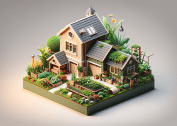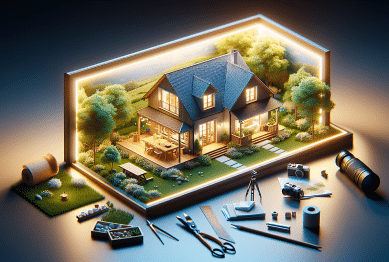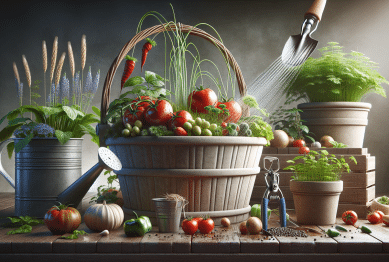Explore how effortless indoor plant styling can transform a living space. From natural air purification to creative design elements, discover the potential of houseplants with practical tips, arrangement ideas, and techniques for making your home greener.
Why Indoor Plants Matter in Home Design
Indoor plant styling goes beyond mere aesthetics. Many people appreciate how a few thoughtfully placed houseplants bring character and harmony to interiors. Plants add freshness, color, and vibrance, making any living room, kitchen, or bedroom feel more alive. Experts agree that indoor greenery contributes to a welcoming environment and delivers a unique touch that personalizes your living area. Moreover, indoor plants can become focal points or subtle accents, depending on your styling approach.https://www.gardeners.com/how-to/houseplants-for-fresh-air/7397.html
Research suggests that having houseplants may even influence well-being on a daily basis. The process of arranging and maintaining indoor greenery can promote mindfulness and stress reduction. Many people report a sense of satisfaction from tending to plants, and this simple act often increases pride in one’s home. Notably, a touch of greenery fits any home style—from minimalist apartments to bohemian retreats and classic spaces.https://www.ncbi.nlm.nih.gov/pmc/articles/PMC4419447/
Air purification is another widely-discussed benefit of indoor plants. NASA studies have explored the capability of common houseplants, such as spider plants and snake plants, to clean the air. These findings have inspired a movement to include live plants as natural air filters, contributing to improved indoor air quality. Experimenting with placements—like near windows or as part of living room décor—can maximize both health advantages and the visual appeal.https://ntrs.nasa.gov/api/citations/19930072988/downloads/19930072988.pdf
Choosing Houseplants for Every Home
For beginners and seasoned gardeners alike, selecting the right houseplants is essential. Each home environment differs in temperature, humidity, and natural light. When choosing, consider care requirements—some plants, such as pothos or ZZ plants, thrive even with minimal attention. Meanwhile, more advanced options, like orchids or fiddle leaf figs, may need dedicated care routines and specific environmental conditions to flourish.https://extension.umn.edu/houseplants/selecting-indoor-plants
If optimal air quality is a goal, certain varieties stand out. Peace lilies, spider plants, and Boston ferns are celebrated for helping to filter out common indoor pollutants. These adaptable options can fit on shelves, desks, or be grouped in statement planters. Spaces with little sunlight may benefit from shade-tolerant plants, such as snake plants or cast iron plants, making them suitable for bathrooms and apartment entryways.https://www.epa.gov/indoor-air-quality-iaq/indoor-plants-and-air-quality
The pet-friendliness of some common houseplants is also worth considering. Not all indoor plants are safe for pets—cats and dogs may be vulnerable to certain species. Fortunately, options like areca palms and parlor palms are generally non-toxic, making them suitable choices for households with animals. Ultimately, a little research into plant characteristics goes a long way in ensuring harmony between your décor and overall safety.https://www.aspca.org/pet-care/animal-poison-control/toxic-and-non-toxic-plants
Creative Plant Arrangement and Display Tips
How you arrange your houseplants can dramatically change a room’s ambience. Layering is a popular method: place tall leafy specimens in corners, use hanging planters to add vertical interest, and group smaller succulents or cacti on shelves and tables. This creates visual variety and encourages the eye to travel throughout the room. When arranging, balance is key; too many plants in one area may feel overwhelming, while strategic clusters foster calm.https://www.rhs.org.uk/advice/profile?PID=768
Mixing textures, colors, and shapes is another effective way to style plants. Pair glossy-leaved varieties next to matte-textured foliage for subtle contrast. Combining plants with variegated leaves and monochrome containers can bring visual intrigue without visual clutter. Accessorizing with unique pots or baskets adds personality, and using plant stands creates height differences—ideal for windowsills or open floor plans where light is abundant.
Repurposing everyday household items—like mason jars, woven baskets, or recycled ceramics—can serve as budget-friendly planters. This not only supports sustainable living but also introduces a DIY element to plant styling. Experiment with placements: a trailing golden pothos hovering on a bookshelf, or a cluster of aloe plants in the kitchen for easy access. The possibilities are limited only by imagination and space.
Maintenance Routines for Vibrant Indoor Plants
Routine care keeps indoor plants at their healthiest. Watering needs depend on plant type, container size, and evolving indoor conditions. Overwatering is one of the most common mistakes; most houseplants prefer to dry out between waterings, especially succulents and cacti. Poke a finger an inch into the soil—if it’s dry, it’s time to water. Room humidity levels, impacted by heating or air conditioning, affect watering frequency, too.
Proper lighting is essential, as is seasonal adjustment. Light requirements vary: some need bright, indirect sun, while others—like snake plants—tolerate low light. Clean dust off leaves every few weeks to ensure optimal photosynthesis. Fertilize monthly during the growing season using a gentle houseplant formula to support lush growth, but cut back during dormant winter months.
Routine pruning and pest checks are key for thriving indoor jungles. Trim yellowing leaves, spent blooms, or overly long stems to maintain healthy growth. Check regularly for pests like spider mites or aphids; catching issues early prevents spread. If you notice drooping, discoloration, or stunted growth, reassess environmental factors like sunlight and moisture. A few minutes of weekly attention keeps foliage vibrant and rewarding all year.
Incorporating Greenery Into Small Spaces
Living in a compact apartment or home need not limit your houseplant journey. Space-saving options abound: slim vertical planters, wall-mounted pockets, and hanging pots utilize every available inch. Terrariums are especially suited for desks or shelves, containing lush mini-ecosystems in glass without sprawling footprints. Large plants, like the statement-making fiddle leaf fig, can be situated by doorways or in unused corners for maximum effect without clutter.
Mirrors can double a room’s perceived greenery, making even one plant look multiplied. Place reflective surfaces behind plant clusters to enhance natural light and visual space. Similarly, multi-level shelving creates layers for trailing or upright varieties, capitalizing on empty wall areas and allowing for low-maintenance rotation depending on available sunlight.
Multipurpose furniture—benches with built-in planters, windowsill trays, or tiered tables—also increases plant options. Choice is not limited to potted specimens. Consider a living wall with modular containers or self-watering systems to transform a plain wall into a vertical garden. The key is creativity: there are styling solutions for every corner, nook, and cranny, regardless of your home’s size.
Seasonal Refresh and Troubleshooting
Refreshing your indoor plant arrangement each season is both fun and practical. As light and temperature change throughout the year, adjusting locations can help plants thrive. Move summer-loving tropicals closer to sunlit windows in winter. Rotate planters to ensure even exposure and symmetrical growth. Incorporate seasonal bloomers—like amaryllis in winter or orchids in spring—for a dynamic, evolving look.
Troubleshooting plant health issues is often part of the houseplant journey. Common concerns include drooping leaves, yellowing, or pest outbreaks. Don’t panic—these are usually fixable. Start by checking for drafts, soil dryness, or sunlight deficits. Repotting root-bound plants or cutting back on water can also restore vitality. Online resources, horticultural extension services, and community groups offer helpful guidance when issues arise.https://extension.psu.edu/indoor-plants-troubleshooting-guide
Engage with plant communities, workshops, or public gardens for fresh ideas and expert tips. Many regions have free or affordable horticultural resources, where professionals and amateurs alike share troubleshooting advice and creative styling inspiration. These connections help transform plant care from a solitary pursuit into a rewarding, shared passion that brings life to any home.https://www.botanicgardens.org/programs/adult-classes
References
1. NASA. (1989). Interior Landscape Plants for Indoor Air Pollution Abatement. Retrieved from https://ntrs.nasa.gov/api/citations/19930072988/downloads/19930072988.pdf
2. U.S. Environmental Protection Agency. (2024). Indoor Plants and Air Quality. Retrieved from https://www.epa.gov/indoor-air-quality-iaq/indoor-plants-and-air-quality
3. The Royal Horticultural Society. (2023). Houseplant Care Guide. Retrieved from https://www.rhs.org.uk/advice/profile?PID=768
4. University of Minnesota Extension. (2023). Selecting Indoor Plants. Retrieved from https://extension.umn.edu/houseplants/selecting-indoor-plants
5. ASPCA. (2024). Toxic and Non-Toxic Plants. Retrieved from https://www.aspca.org/pet-care/animal-poison-control/toxic-and-non-toxic-plants
6. Penn State Extension. (2023). Indoor Plants: Troubleshooting Guide. Retrieved from https://extension.psu.edu/indoor-plants-troubleshooting-guide









